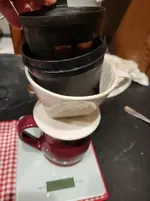Bewilderness
New member
Greetings all (and especially you pour over experts out there)...My one-cup automatic drip maker of 20 years quit on me a few months back, and after some experimenting with French press (which I liked) I decided to try pour over for the lack of silt and easier cleanup. I ordered a Kalita 102 funnel and a couple of Coffee Sock cloth filters, and I upgraded from my Hario Original burr grinder to a Comandante. Coffee:water ratios are still fairly new as I did everything by volume previously, so at present I'm still using oz instead of grams. Here are my current parameters:
- 2T/0.5oz beans: 6oz water + 1/4 cup for bloom OR 3T/0.75oz beans: 9oz. water + 1/3-1/2 cup for bloom
- Water at the higher end of the 95-105 range, just off the boil
After much trial and error, I've determined a few things:
- To avoid under-extraction and a sour flavor, I have to use a setting 14 which is close to an espresso grind.
- Cloth filters absorb less oil than paper but still too much, so I've switched to the metal mesh filter scuttled from my drip brewer for time being.
- Even using a fine grind I have to use the outer filter basket with one drain hole to keep the water from draining too quickly. This means the Kalita funnel provides support but nothing else, so I presumably(?) need a different funnel/filter that "bathes" the grounds for a longer period as the water drains.
- Pouring speed does not seem to make a difference, and if anything a "slower" pour that goes around the edges and keeps the grounds level produces sour coffee.
I've attached a pic of my current setup, which is a bit ridiculous but it's where I am right now. My remaining questions are these:
- 2T/0.5oz beans: 6oz water + 1/4 cup for bloom OR 3T/0.75oz beans: 9oz. water + 1/3-1/2 cup for bloom
- Water at the higher end of the 95-105 range, just off the boil
After much trial and error, I've determined a few things:
- To avoid under-extraction and a sour flavor, I have to use a setting 14 which is close to an espresso grind.
- Cloth filters absorb less oil than paper but still too much, so I've switched to the metal mesh filter scuttled from my drip brewer for time being.
- Even using a fine grind I have to use the outer filter basket with one drain hole to keep the water from draining too quickly. This means the Kalita funnel provides support but nothing else, so I presumably(?) need a different funnel/filter that "bathes" the grounds for a longer period as the water drains.
- Pouring speed does not seem to make a difference, and if anything a "slower" pour that goes around the edges and keeps the grounds level produces sour coffee.
I've attached a pic of my current setup, which is a bit ridiculous but it's where I am right now. My remaining questions are these:
- Why do I have to use a near-espresso level grind to achieve the same result with the same filter, when I was using essentially a "cowboy" grind previously with my automatic drip brewer?
- Can someone settle once and for all which pour over funnel shapes are called what? A funnel with a truncated cone shape – i.e., a round cross-section – such as the Kalita Wave *should* be called a “cone” filter, but for some reason it’s called “flat-bottom.” The shape that is actually called a cone filter (like mine) is actually a wedge shape with a rectangular (and also flat) bottom, or alternately an actual cone with a pointy bottom end. How does any of this make sense?
- No blog has consistently explained which funnel shape produces what flavor profile. Some say that a flat-bottom is better suited to medium roasts as it creates a bolder, more full-bodied flavor (which is what I want), while a cone filter (the wedge/rectangle kind) is better for light roasts as it produces more acidity. Other blogs say just the opposite. There is no specific info on a pointy cone funnel.
- Paper and cloth filters (the things that actually hold the grounds back, as opposed to funnels) are discussed as if absorbing coffee oils and the flavors they carry is a good thing. What if I want the oils in my coffee, as a counterbalance to the acidity? Surely I’m not alone here…
- Is there a reason one would choose a funnel with its own base, that can sit on a coffee mug rim, instead of a separate stand – or vice versa?
- Lastly, I do not understand how pouring speed makes a difference if the grind and the number/size of drain holes determines how fast gravity pulls the water through the grounds.
Attachments
Last edited:

